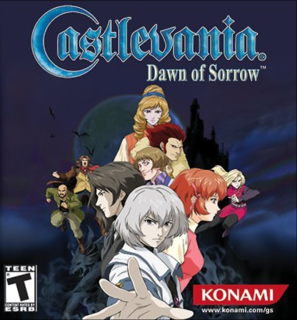Whether you're new to Castlevania, a long-time fan, or haven't played since its NES days, you won't be disappointed.
The DS sequel to Aria of Sorrow renews the story that began on the Game Boy Advance. One year ago, Soma Cruz discovered that he was destined to become the new Dark Lord. As the reincarnation of Dracula, Soma possesses the ability to absorb the souls of monsters he’s killed, gaining new abilities and spells. Not too keen on the idea of being reborn as the king of evil, Soma and pals escaped from Dracula’s castle. A year after these events, a mysterious priestess named Celia establishes a cult with the sole purpose of resurrecting Dracula. Shocking? Not really. Inventive? No. But it’s a hell of a lot of fun.
Dawn of Sorrow plays exactly like its GBA predecessors. Soma starts off relatively weak, and there are many areas of the castle you cannot explore yet. As you defeat enemies, acquire equipment, and purchase maps, additional areas of the fortress will open up. The soul system from Aria of Sorrow returns and has been completely revamped. Collecting enemies’ souls is an addicting, Pokemon-esque endeavor that will yield one of four different results. Bullet-type souls grant Soma various special attacks that typically enhance his ability to throw projectiles. Guardian-type souls consume magic points as they are used and can be employed a number of ways including summoning enemies to fight on your side, firing a devastating laser beam, transforming yourself into various creatures. Enchant-type souls grant Soma special abilities or enhance his stats without ticking away at your magic points. By defeating bosses, Soma absorbs Ability souls, such as the double jump, that allow access to new areas of the castle. Equipping different combinations of souls creates new abilities and affects your character’s stats in various ways. Additionally, the game allows you to switch between two different configurations on the fly by pressing the X button. It’s an excellent feature and really enhances the game’s strategy.
Stylistically, Dawn of Sorrow doesn’t stray far from its GBA roots. Throughout each of the castle’s regions, you’ll notice a number of different themes that all fit nicely with the Castlevania series. The DS, however, allows for more intricate detail than the GBA, and it shows. Enemies will often occupy the entire screen, and some are given full 3D animations. Each background is vividly brought to life through scrolling environments that approach Symphony of the Night quality. Graphically, Dawn of Sorrow is everything you’ve come to expect from the Castlevania series and more. The DS speakers also lend to some of the best music found in any game. The eerie tone and beautiful composition of the pieces engross the player in the world of Castlevania. Sound effects are also crystal clear and well-suited to the game.
Speaking of the DS hardware, Dawn of Sorrow does employ a handful of exclusive features. Throughout the game, a map of the castle is conveniently displayed on the top screen revealing the locations of exceptionally well-placed save points and transporters. An admittedly minor yet oddly fulfilling ability to sign your name on save files rather than typing it in is also a nice touch. Aside from that, the only major use of the touch screen comes when a boss is defeated and you must quickly draw one of five patterns to seal the demon away before it regenerates. These patterns are scattered throughout the game and must be found to be used. If you don’t scribble down the pattern fast enough, the boss returns with a small but substantial amount of life left, and you must repeat the process. In theory, this is a nice feature. Unfortunately, it doesn’t pan out as well as the developers might have hoped because it really only serves to frustrate players who have just finished an exceptionally frantic boss battle.
Long-running fans of the series will not be disappointed with Dawn of Sorrow. It plays fairly easily, but you’ll quickly become addicted to collecting the souls of all 100+ enemies. Anyone familiar with Castlevania 3: Dracula’s Curse on the NES is in for a particularly appealing treat. Unlocking the game’s ‘Julius Mode’ allows you to play tag-team style as Julius Belmont and two other main characters, each with their own strengths and abilities. Complete with retro music, holy water, and that classic whip, Julius mode gives Dawn of Sorrow a much longer lifespan.
Despite its minor flaws, Dawn of Sorrow is one of the best games available on a portable system. It’s a must-have for any Castlevania or Metroid fan, and is a near-perfect reason to own a Nintendo DS. Whether you’re new to Castlevania, a long-time fan, or haven’t picked it up since its NES glory days, you won’t be disappointed with Dawn of Sorrow.

